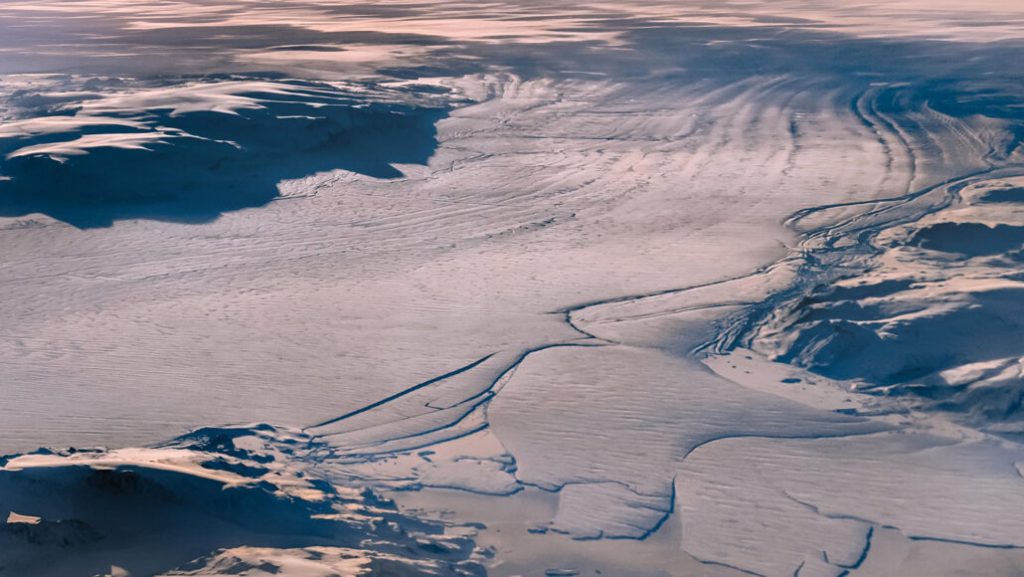Greenland’s frozen hinterlands are bleeding worse than we thought

Sea level rise may proceed faster than expected in the coming decades, as a gargantuan flow of ice slithering out of Greenland’s remote interior both picks up speed and shrinks.
By the end of the century, the ice stream’s deterioration could contribute to nearly 16 millimeters of global sea level rise — more than six times the amount scientists had previously estimated, researchers report November 9 in Nature.
The finding suggests that inland portions of large ice flows elsewhere could also be withering and accelerating due to human-caused climate change, and that past research has probably underestimated the rates at which the ice will contribute to sea level rise (SN: 3/10/22).
“It’s not something that we expected,” says Shfaqat Abbas Khan, a glaciologist at the Technical University of Denmark in Kongens Lyngby. “Greenland and Antarctica’s contributions to sea level rise in the next 80 years will be significantly larger than we have predicted until now.”
In the new study, Khan and colleagues focused on the Northeast Greenland Ice Stream, a titanic conveyor belt of solid ice that crawls about 600 kilometers out of the landmass’s hinterland and into the sea. It drains about 12 percent of the country’s entire ice sheet and contains enough water to raise global sea level more than a meter. Near the coast, the ice stream splits into two glaciers, Nioghalvfjerdsfjord and Zachariae Isstrøm.
While frozen, these glaciers keep the ice behind them from rushing into the sea, much like dams hold back water in a river (SN: 6/17/21). When the ice shelf of Zachariae Isstrøm collapsed about a decade ago, scientists found that the flow of ice behind the glacier started accelerating. But whether those changes penetrated deep into Greenland’s interior remained largely unresolved.
“We’ve mostly concerned ourselves with the margins,” says atmosphere-cryosphere scientist Jenny Turton of the nonprofit Arctic Frontiers in Tromsø, Norway, who was not involved in the new study. That’s where the most dramatic changes with the greatest impacts on sea level rise have been observed, she says (SN: 4/30/22, SN: 5/16/13).
Keen to measure small rates of movement in the ice stream far inland, Khan and his colleagues used GPS, which in the past has exposed the tortuous creeping of tectonic plates (SN: 1/13/21). The team analyzed GPS data from three stations along the ice stream’s main trunk, all located between 90 and 190 kilometers inland.
The data showed that the ice stream had accelerated at all three points from 2016 to 2019. In that time frame, the ice speed at the station farthest inland increased from about 344 meters per year to surpassing 351 meters per year.
The researchers then compared the GPS measurements with data collected by polar-orbiting satellites and aircraft surveys. The aerial data agreed with the GPS analysis, revealing that the ice stream was accelerating as far as 200 kilometers upstream. What’s more, shrinking — or thinning — of the ice stream that started in 2011 at Zachariae Isstrøm had propagated more than 250 kilometers upstream by 2021.
“This is showing that glaciers are responding along their length faster than we had thought previously,” says Leigh Stearns, a glaciologist from the University of Kansas in Lawrence, who was not involved in the study.
Khan and his colleagues then used the data to tune computer simulations that forecast the ice stream’s impact on sea level rise. The researchers predict that by 2100, the ice stream will have singlehandedly contributed between about 14 to 16 millimeters of global sea level rise — as much as Greenland’s entire ice sheet has in the last 50 years.
The findings suggest that past research has probably underestimated rates of sea level rise due to the ice stream, Stearns and Turton say. Similarly, upstream thinning and acceleration in other large ice flows, such as those associated with Antarctica’s shrinking Pine Island and Thwaites glaciers, might also cause sea levels to rise faster than expected, Turton says (SN: 6/9/22, SN: 12/13/21).
Khan and his colleagues plan to investigate inland sections of other large ice flows in Greenland and Antarctica, with the hopes of improving forecasts of sea level rise (SN: 1/7/20).
Such forecasts are crucial for adapting to climate change, Stearns says. “They’re helping us better understand the processes so that we can inform the people who need to know that information.”